19 - Stars
1/45
There's no tags or description
Looks like no tags are added yet.
Name | Mastery | Learn | Test | Matching | Spaced |
|---|
No study sessions yet.
46 Terms
what is a nebula?
why are they referred to as stellar nurseries?
- Nebulae are gigantic clouds of dust and gas (mainly hydrogen)
- nebulae are the birthplace to all stars
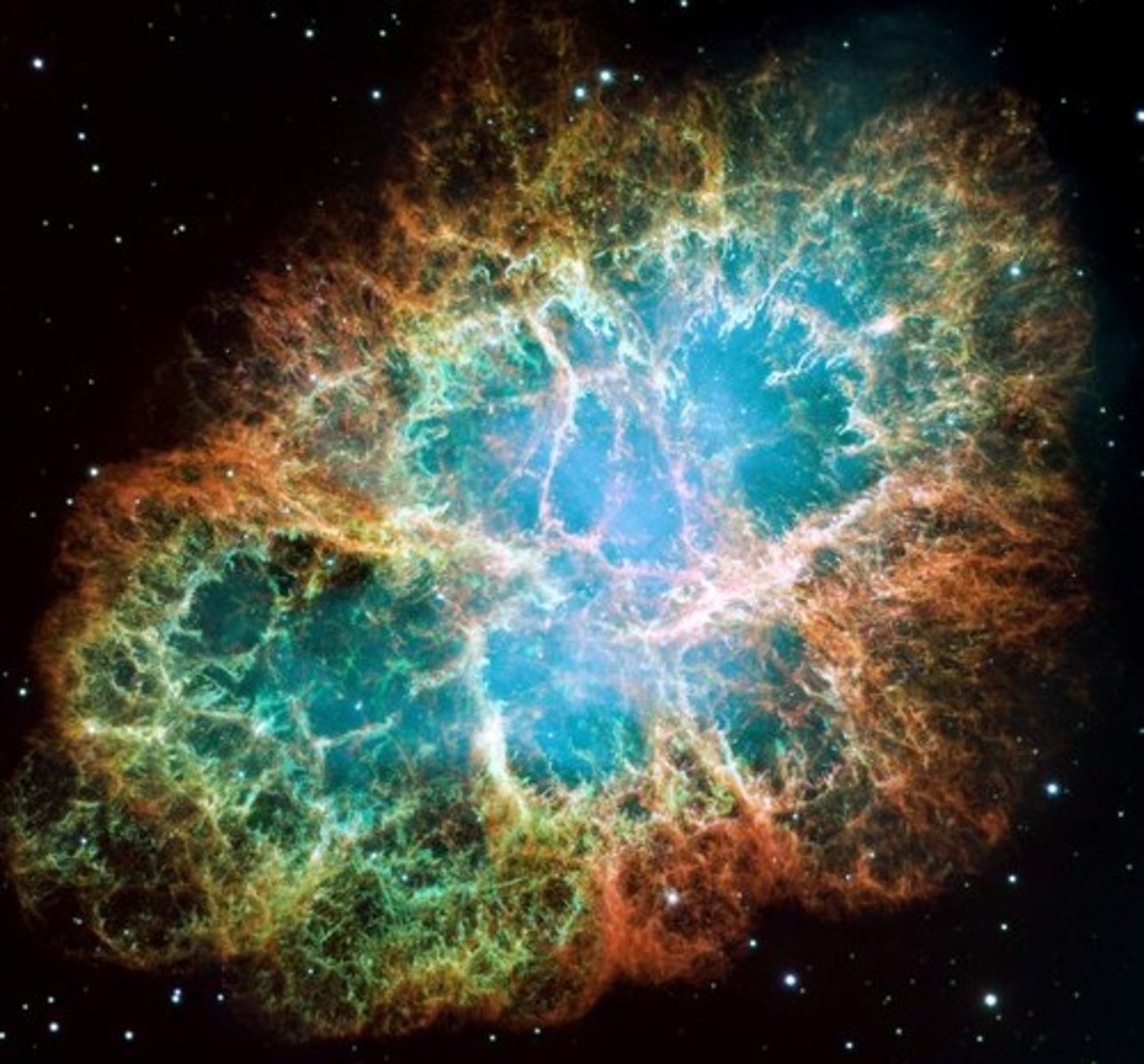
how is a gas cloud formed?
tiny gravitational attraction between particles of dust and gas pulls the particles towards each other, forming vast clouds
how is a protostar formed in a nebula?
- dust and gas get closer and gravitational collapse accelerates
- due to tiny variations in the nebula, denser regions begin to form
- regions become hotter as gravitational energy transfers to thermal energy
- a protostar is formed; a very hot dense sphere of dust and gas
how does a protostar form into a star?
Nuclear fusion must start in its core
- high pressures and temperatures, created from the gravitational collapse, inside the core allow hydrogen to have such large kinetic energy to overcome the electrostatic repulsion between the hydrogen nuclei allowing them to fuse together and produce helium
→ A star is born
how does a star remain in stable equilibrium
gravitational forces compressing the star is in equilibrium with the radiation pressure from photons emitted during fusion & the gas pressure outwards
what phase of a star's life is it called when it is in stable equilibrium
main sequence
do larger stars remain in main sequence longer or smaller?
why?
cores of larger stars are much hotter, releasing more power & converting available hydrogen into helium in a much shorter time
- Therefore, larger stars need to produce more energy to maintain equilibrium
- even though they have more fuel, they remain on the main sequence for a shorter time than smaller stars due to a greater rate of fusion
why do stars with lower mass remain in their main sequence longer?
- have lower mass so they are cooler so their rate of fusion can be slower
when does a star finish its main sequence?
when its hydrogen fuel runs low
explain how stars with 0.5M☉ < M < 10M☉ after its main sequence become a red giant and then a white dwarf surrounded by a planetary nebula
for stars with 0.5M☉ < M < 10M☉:
- hydrogen runs low so gravitational force > outward radiation force
- core begins to collapse
- core shrinks, increasing pressure enough to start fusion in a shell around the core
- Red Giants have inert cores (fusion no longer happens) because there is small amount of hydrogen left & temp not enough for helium to fuse
- fusion of hydrogen into helium continues in shells around core
- layers start drifting away forming a planetary nebula leaving behind the hot intert core as a white dwarf.

describe a white dwarf
does fusion reactions carry on in a white dwarf?
how does it emit photons?
very hot and very dense with no fusion reactions but it emits photons from its earlier evolution
What is Pauli's exclusion principle?
what stops the white dwarf from gravitationally collapsing?
Pauli's exclusion principle is that two electrons cannot occupy the same energy level
- in a white dwarf, due to its high density, electrons are forced to occupy all the available energy levels
- as energy levels are filled, electrons create a counter pressure stopping further compression called electron degeneracy pressure
what is the limit for electron degeneracy pressure?
the Chandrasekhar limit states that electron degeneracy pressure can only stop the gravitational collapse of the inert core only if its mass is < 1.44 M☉
what is electron degeneracy pressure
as energy levels are filled, electrons create a counter pressure stopping further compression called electron degeneracy pressure
how do stars with mass > 10M☉ become red supergiants
stars with mass < 10M☉ have much hotter cores due to higher mass
- consume their hydrogen faster than smaller stars
- helium formed from the fusion of hydrogen nuclei have enough energy to overcome electrostatic repulsion so fusion of helium nuclei into heavier nuclei also occurs
- Those nuclei also fuse, forming a series of shells
- increases core temperatures and expands becoming a red supergiant
how does a supernova occur?
in red supergiants, temperatures and pressure is so high to fuse massive nuclei together forming a series of shells inside the star each in which different elements are created by fusion with heavier elements deep in the core
- the central core is made of iron
- iron nuclei cannot fuse together so fusion at central core stops
- without fusion, there is no outward pressure to balance gravitational force
- iron core collapses & outer layers collapse inwards
- outer layers smash into the core, bounce off the core leading to a shockwave
- shockwave ejects all the material into space called a supernova
what two objects can form after a supernova ?
neutron star or black hole
how is a neutron star formed?
If the mass of the core is greater than the Chandrasekhar limit, the gravitational collapse cannot be stopped by electron degeneracy pressure
- electrons are pushed into the nucleus and interact with protons and form neutrons
- neutrons also follow Pauli's exclusion principle
- if the core < 3M☉, neutron degeneracy pressure stops the collapse
- resulting in a neutron star
- typically 2M☉, 10KM in diameter
how is a black hole formed
if the core is larger than 3M☉, neutron degeneracy pressure cannot stop the gravitational collapse so core continues to be compressed
- collapsing core creates a gravitational field so strong, an object would need an escape velocity greater than the speed of light
- a black hole is formed
how are some elements heavier than iron distributed across the universe?
- supernovae create all the heavy elements
- elements heavier than iron are formed during a supernova which then distribute them throughout the universe
What is the Hertzsprung-Russell diagram?
A log-log plot of luminosity (on the y-axis) against average surface temperature (backwards on the x-axis) for a group of stars.
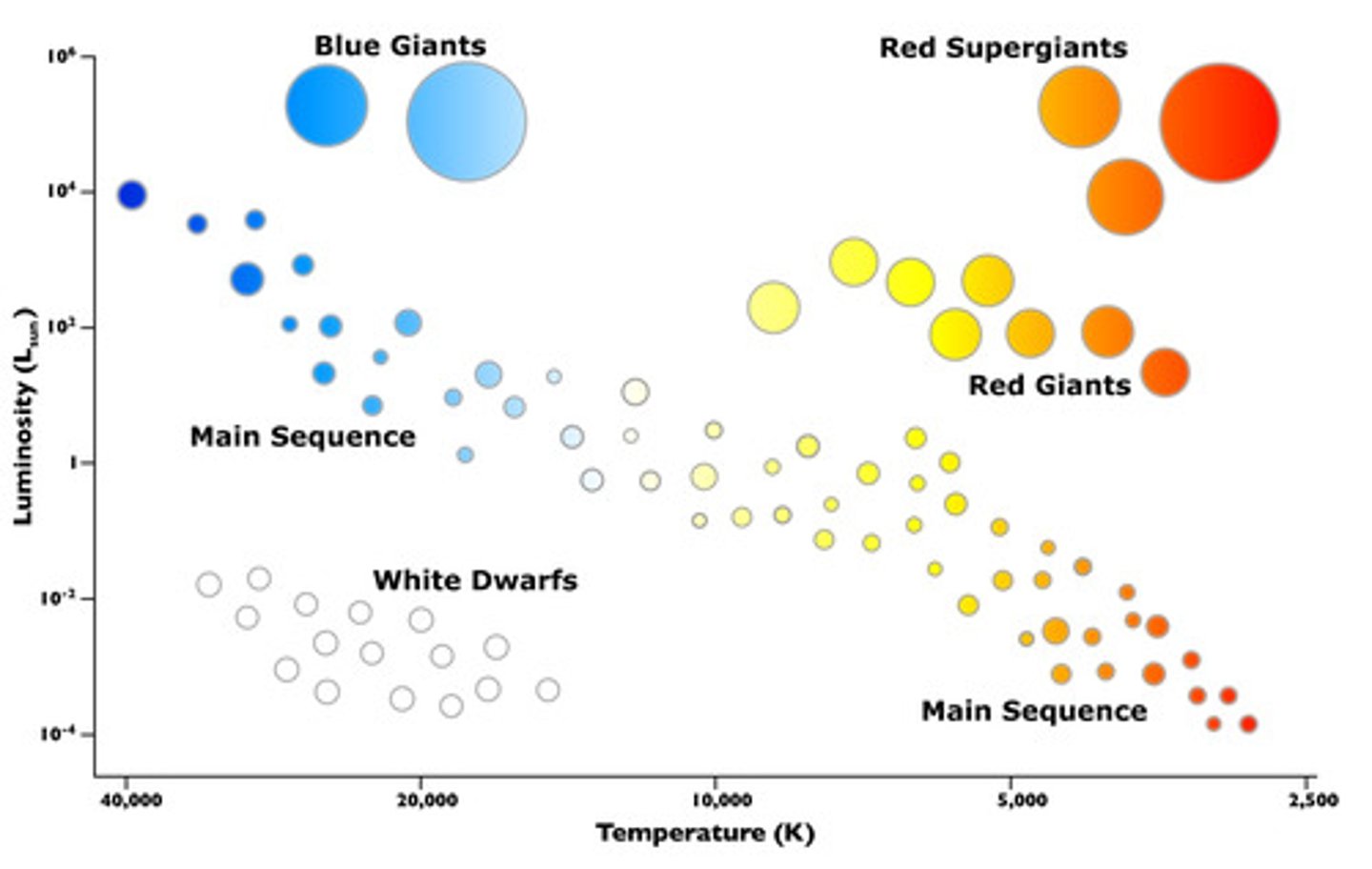
for a Hertzsprung-Russel diagram, how do we plot the luminosity on the y axis
the ratio of the luminosity of the star and the luminosity of the sun
Define the luminosity of a star.
Amount of energy radiated by the star per second (sun has luminosity of 3.85x10²⁶W)
on the H-R diagram, where are the stars on their main sequence?
they form a curved line from the top left corner to the bottom right corner
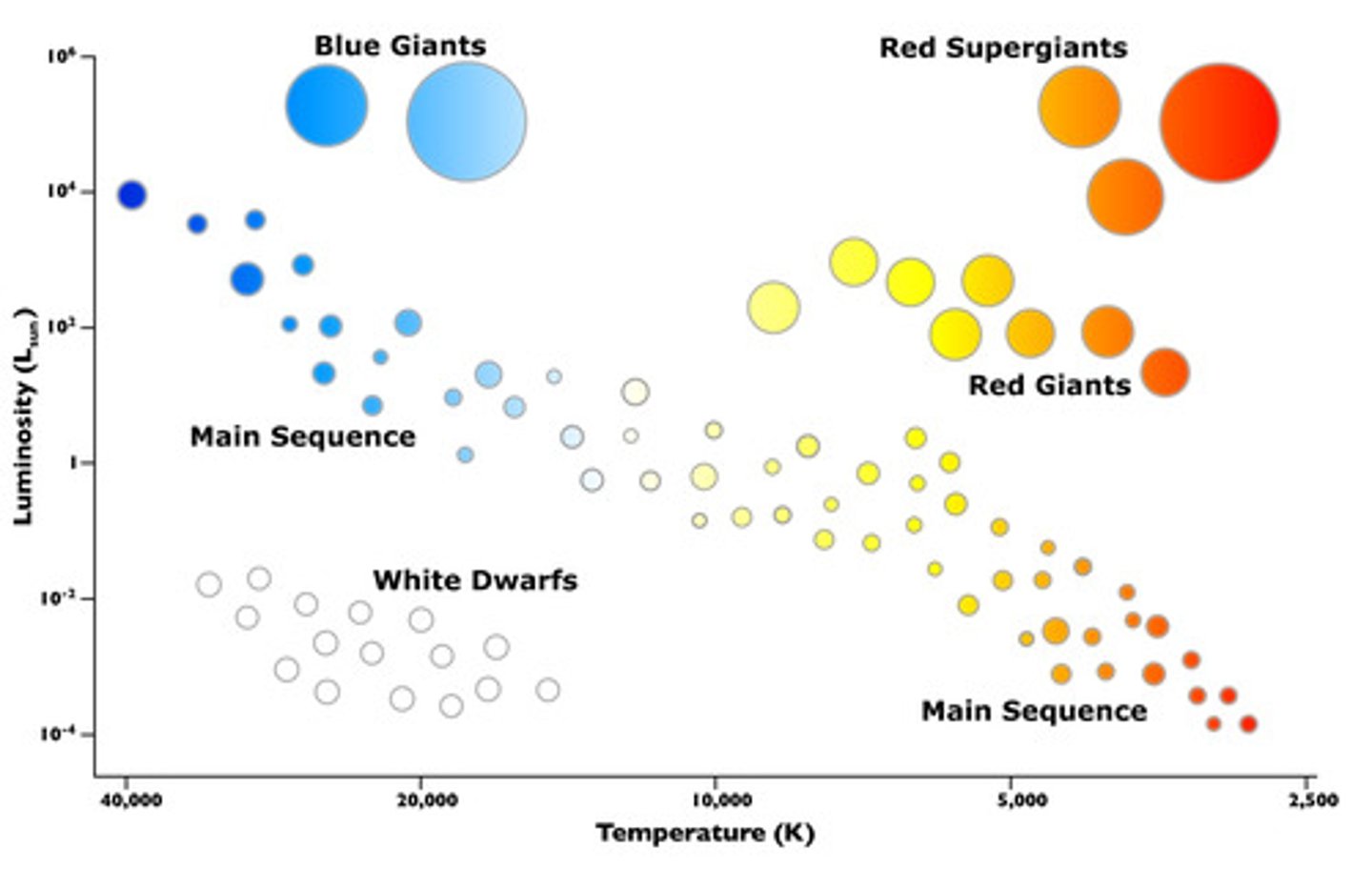
where do white dwarfs appear on the H-R diagram
- they are hot and dim so bottom left

Where are Red Supergiants on the HR diagram?
very luminous due to vast size, but low surface temp
so top right
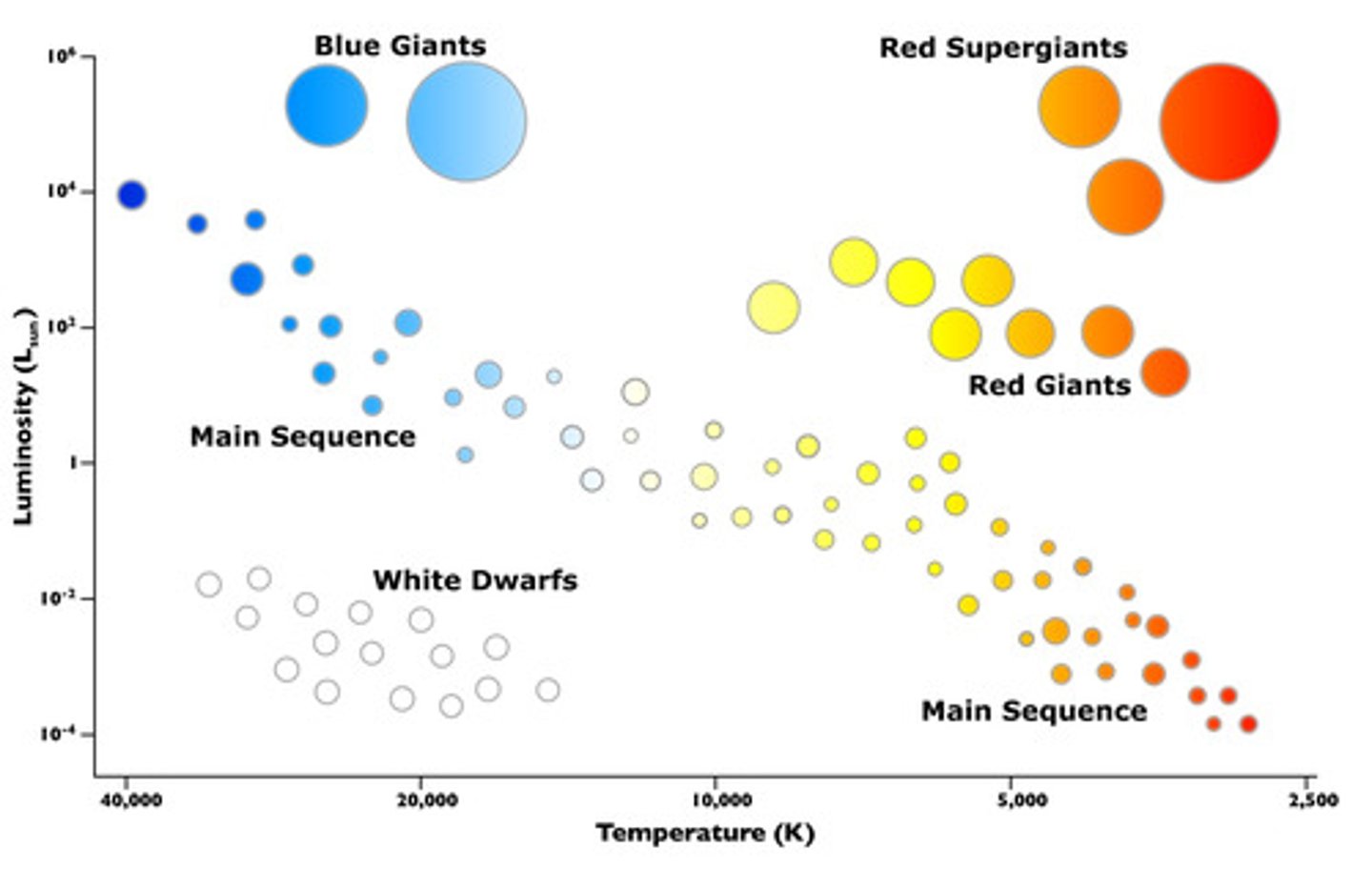
Where are red giants on the H-R diagram?
upper right splitting from the main sequence line
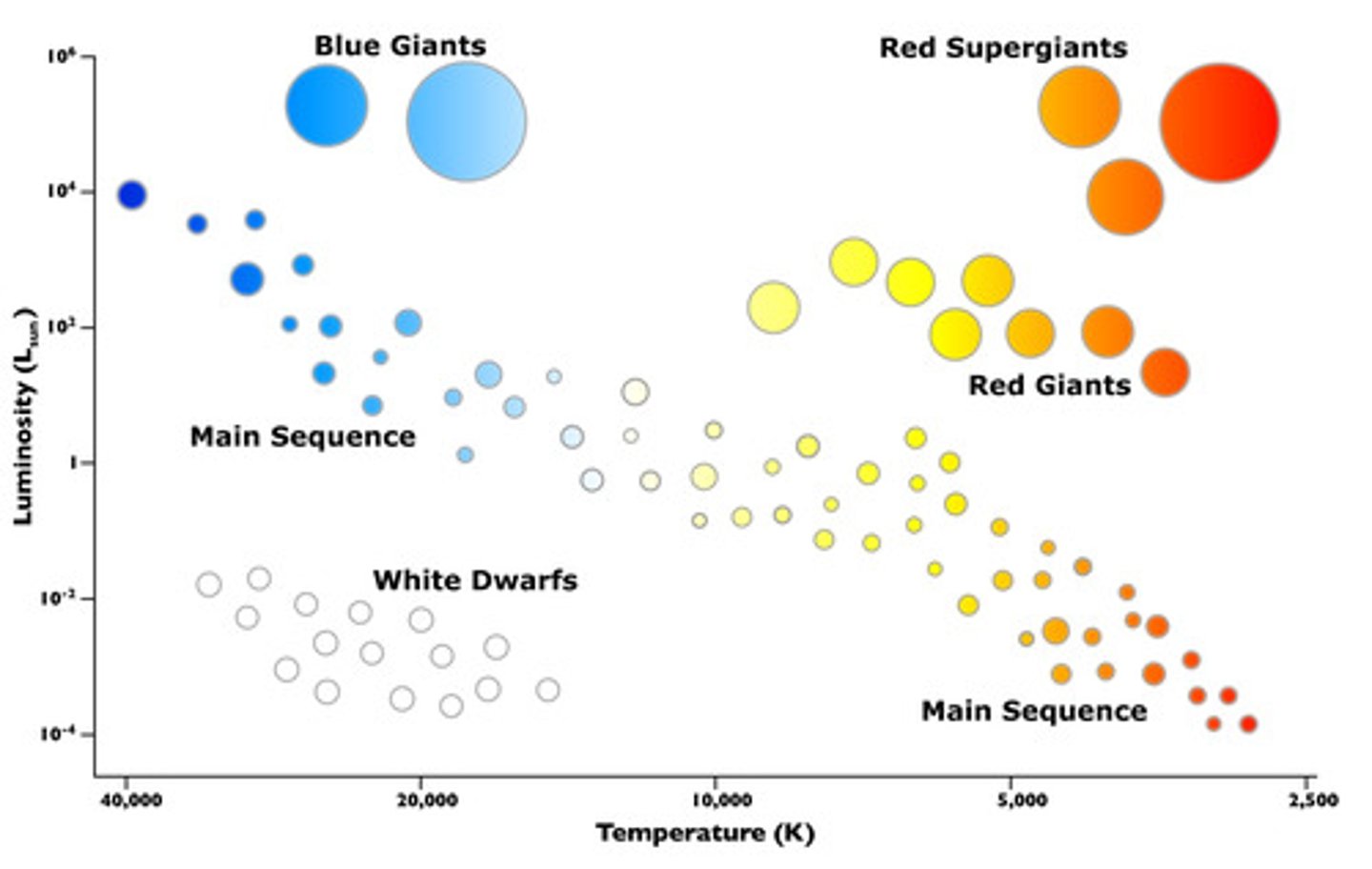
on the H-R diagram, what path does the life cycle of a small mass star take (0.5☉
- these stars evolve into red giants, then lose outer layers and become white dwarfs
- move to the upper right with red giants then to bottom left with white dwarfs
on the H-R diagram, what path does the life cycle of a higher-mass star take (M>10☉)
start at the top left with high luminosity high temp
then rapidly consume fuel and lose temp but not luminosity, so become supergiants at top right before they go supernova
How do energy levels in gas atoms work?
why are the energy levels negative?
an electron with zero energy is considered what from the atom?
can an electron exist between two energy levels?
what is the energy level with the most negative value called?
electrons can only exist in one of a discrete set of energy levels
energy levels are negative because external energy is required to remove an electron from the atom
an electron with 0J energy is free from the atom
an electron cannot have a quantity of energy between two levels
the energy level with the most negative value is known as the ground level/ground state
what does it mean when an atom is excited?
raising an electron into a higher energy level by putting in external work
what can excite an electron?
A photon with a specific energy, which is = △E from one energy level to the other
what does it mean when an atom is de-excited
when an electron moves from a higher energy level to a lower energy level and emits a photon of energy = △E of the two energy levels
what is special about energy levels in every element
every element has their own unique set of energy levels
What does the emission-line spectrum look like?
what does each line correspond to?
how does an element produce one?
a spectrum consisting of bright lines at specific wavelengths agasint a dark background where each line corresponds to the wavelength of light emitted by stoms when their electrons transition form higher to lower energy levels
what is the continuous spectrum
A continuous spectrum contains all wavelengths of light in a certain range produced by a hot dense object like the sun
what is absorption line spectrum?
what does each line correspond to?
a continuous spectrum with dark lines at specific wavelengths, where each line corresponds to a wavelength of light used to excite atoms of that element
how is absorption line spectrum produced for gas atom?
when light from a source that produces a continuous spectrum passes through a gas:
- some photons are absorbed by atoms raising electrons into higher energy levels
- only photons with E = △E between energy levels are absorbed
- the absorbed light is missing from the spectrum when it reaches the observer, creating dark absorption lines
- the absorbed energy is later re-emitted but in all directions so the intensity in the original direction is greatly reduced
how can we, using absorption line spectra, determine what elements may be present in a star
- When detecting light from a star, it is found to be an absorption line spectrum
- The core of the star emits a continuous spectrum of radiation
- The outer layers of the star absorb specific wavelengths of light corresponding to their energy levels creating an absorption line spectrum
- If we know the line spectrum for a particular element, we can check whether the element is present in the star
What is a diffraction grating?
an optical component with regularly spaced slits or lines that diffract and split light into beams of different colour travelling in different directions
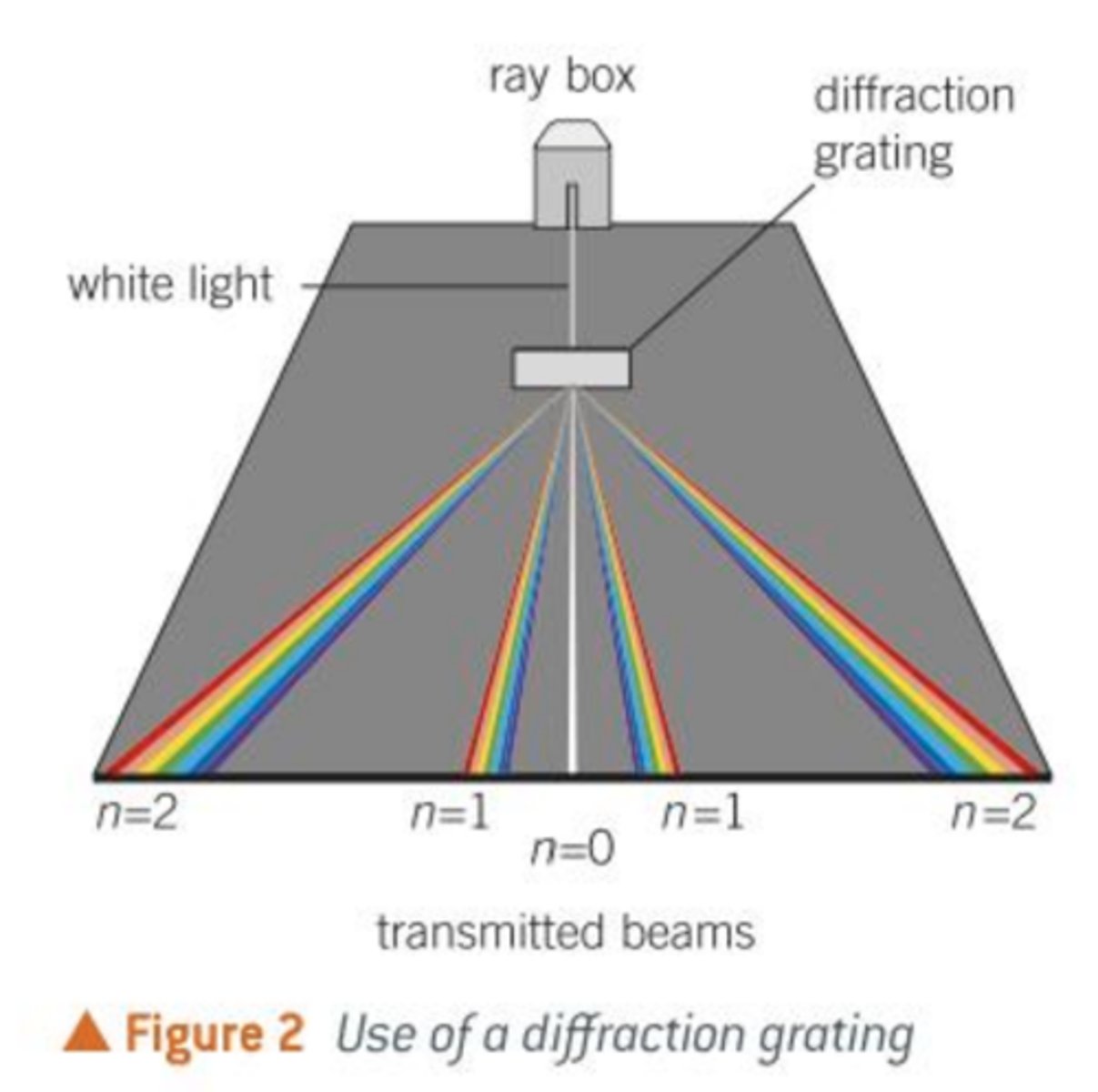
what is an advantage of using a diffraction grating over two standard slits
the fringes produced by a double slit is not sharp, but a diffraction grating has many slits producting a clearer & brighter interference pattern
how are minimas and maximas formed from a diffraction grating
explain how the orders of maxima work
- Monochromatic light passing through the diffraction grating diffracts
- diffracted light superposes & creates, depending on the path difference and phase difference, minima at points of destructive interference and maxima at constructive interference
- 0th order maxima at centre, 1st order maximas occur either side of the 0th order
Explain how to determine the wavelength of monochromatic light using a diffractionaction grating
- shine monochromatic light through a diffraction grating, and there will be a series of minima and maxima (interference pattern)
- if you know the slit separation 'd', the order of maxima 'n', and the angle between this maxima and the normal to the diffraction grating '𝛳', you can use
d sin𝛳 = nλ
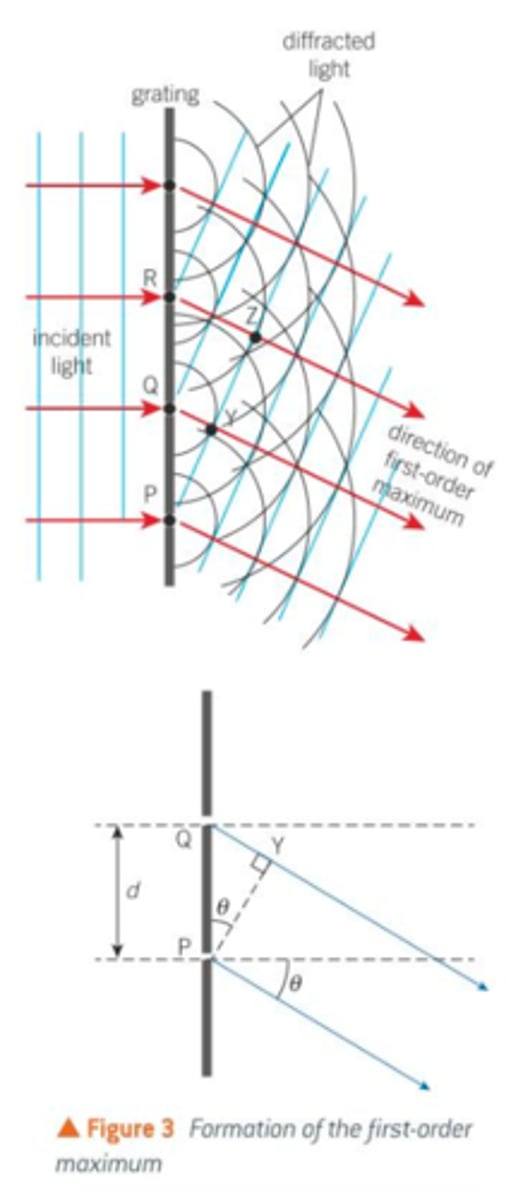
explain the graph of an intensity wavelength grpah for a star
explain λmax
explain how it can vary with temp
what is Weins displacement law
how does it relate to this graph?
how can we use this law and graph for a star
- emits a continuous spectrum of EM radiation
- The graph shows the intensity of each different λ emitted by the star
- at the peak occurs λmax
- λmax is the λ the star emits at maximum intensity
- Wein's displacement law is that λmax ∝ 1/T
- where T is the surface temperature of the star
- This means that decreasing the temperature of the surface of the star will shift graph right as λmax increases
- The peak intensity also drops as there is less total radiant power at a lower temp
- the opposite happens at a higher temp
- we can use this graph to estimate the surface temp of a star
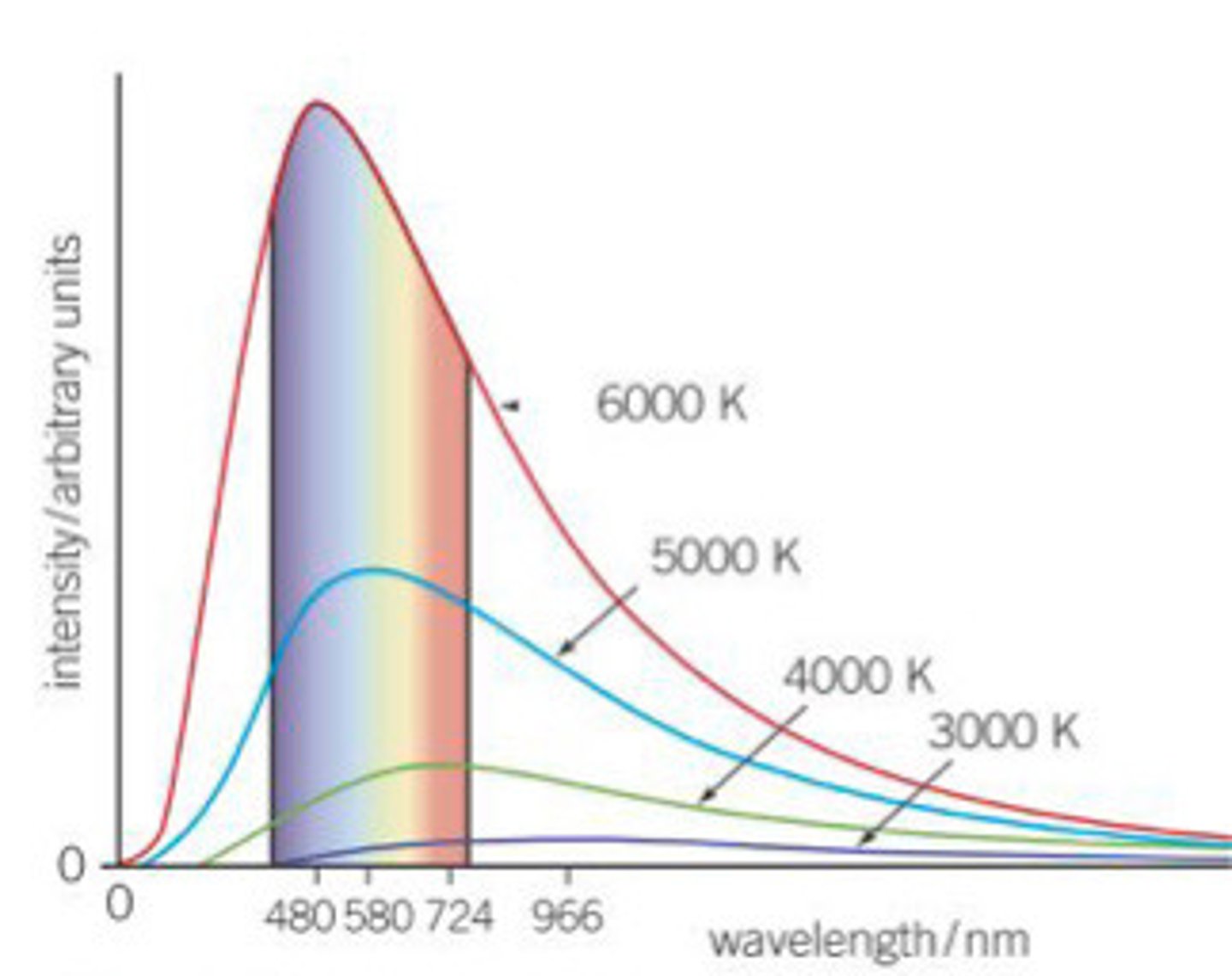
what is luminosity of a star
The luminosity of a star is the total energy it emits per unit time
What is Stefan's Law?
what is the equation?
The total power radiated per unit surface area by a black body is directly proportional to the 4th power of the absolute temperature
- L = 4πr²𝜎T⁴
r = radius of star, T = absoulate surface temp of star, 𝜎 = stefans constant, 4πr² = surface area